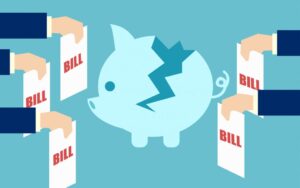Due upon receipt: Medical debt threatens the livelihoods of West Virginians
Ellen Allen
You owe $8,580.07, payable to the hospital now.
- Room and Board
- Emergency Room
- Cardiology
- Radiology
- Pharmacy
- Laboratory
- Physician fees
This is an actual bill someone close to me received last month after a visit to a local West Virginia hospital that resulted in a nonadmission, but required observation and diagnostic testing. The total cost of their less than 24 hour visit was $27,340.76.
The patient — my friend — was quick to add that they received excellent care. This story is not about a particular hospital or about inadequate care. It is about the state of health care affordability and how medical debt threatens our economic security, issues that are at the very heart of the mission of West Virginians for Affordable Health Care.
My friend has health insurance with a $3,800 deductible and a maximum out-of-pocket cost of $9,200 annually. This is the cost sharing, in other words, it’s what the patient owes after the insurance has made their share of payments and adjustments. That’s a lot of money.
The facts
The Peterson-KFF Health System tracker analysis of government data estimates that people in the United States owe at least $220 billion in medical debt. Approximately 14 million people (6% of adults) in the U.S. owe over $1,000 in medical debt and about 3 million people (1% of adults) owe medical debt of more than $10,000.
At 13.3%, West Virginia is one of the states with the highest share of its residents carrying medical debt. Other states with a high share of adults with medical debt include South Dakota at 17.7%, Mississippi at 15.2% and North Carolina at 13.4%.
In case you are curious, medical debt for dental care is included.The deficit in dental coverage is immense: Nearly 69 million U.S. adults did not have dental insurance or access to routine oral health care last year, according to a survey by the nonprofit CareQuest Institute for Oral Health. Millions more lost dental insurance last year when states began to unwind Medicaid coverage for people who signed up during the COVID-19 pandemic. More on the cost and accessibility of dental care in future commentary.
Why this matters
According to KFF polling, people with medical debt report cutting spending on food, clothing and other household items, spending down their savings to pay for medical bills, borrowing money from friends or family members, or taking on additional debts. (The KFF polling found that 41% of adults have health care debt according to a broader definition, which includes health care debt on credit cards or owed to family members.)
Medical debt can set an individual up for future poverty that they may not feel at the time that the debt is accrued. Just think, you are presented with a bill even bigger than the one my friend received. You must decide whether to finance the debt against monthly installments or exercise a hardship withdrawal from your 401(k). Or even worse, maybe you don’t even have retirement savings from which to draw.
Some people lose their homes. Some empty their retirement accounts. Some struggle to feed and clothe their families. Medical debt — including short and long term debt — now touches tens of thousands of West Virginians and more than 100 million people in America, as the U.S. health care system pushes patients into debt on a massive scale. Debtors are from all walks of life, all corners of the Mountain State and across this country.
Medical debt can be a barrier to career growth and increasing one’s economic stability: Employers commonly use credit checks to evaluate candidates for employment.
Red flags on a credit report include late payments, long-term debts or total debt — including student loans, mortgages, and medical debt — that exceeds 40% of the person’s income.
However, research from the federal Consumer Financial Protection Bureau suggests medical debts should be treated differently than other debts.
The CFPB found that unlike credit card debt, medical bills that have gone to collections aren’t an accurate predictor of someone’s likelihood to pay bills. In fact, the agency determined that people with “paid medical collections were less likely to be delinquent than other consumers with the same credit score.”
But running credit checks on job candidates remains common. For those with medical debt, that can mean being turned away from jobs because of the bills they are trying to pay off. This doesn’t really make sense. Afterall, one is trying to do the right and responsible thing. It doesn’t take much to spiral out of control.
What do we do?
A new proposal by the Biden administration would protect Americans from having their credit history cratered by medical bills.
The rule change, announced by the Consumer Financial Protection Bureau on June 11, 2024, would prevent almost any medical debt from appearing on credit reports. In a statement, the CFPB said medical bills “have little to no predictive value when it comes to repaying other loans.“
In 2022, the three largest credit bureaus — TransUnion, Equifax and Experian — started removing paid medical debts from consumers’ credit reports. The following year, they stopped including outstanding balances under $500.
FICO and VantageScore, the two major credit scoring companies, have also decreased the degree to which medical bills impact credit scores.
Medical debt can still have significant financial consequences, though, leaving you with fewer options for housing, loans and credit cards.
Health care bills are the number one cause of bankruptcies in the United States.
At West Virginians for Affordable Health Care, we believe an everyday medical bill should not bankrupt any West Virginian.
Originally published by https://westvirginiawatch.com/2024/08/29/due-upon-receipt-medical-debt-threatens-the-livelihoods-of-west-virginians/
